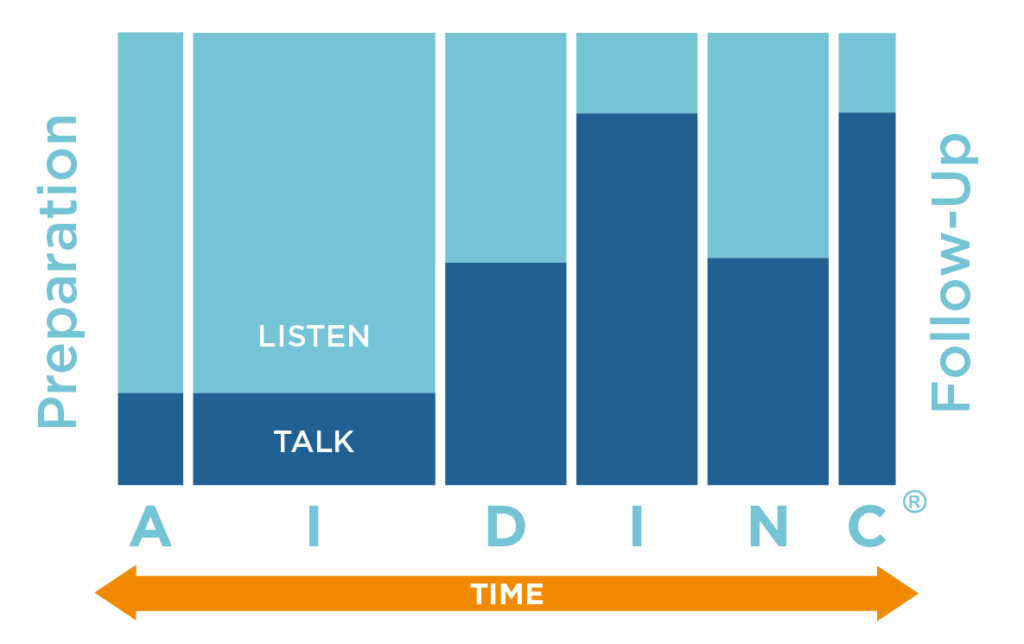Mastering Sales Conversations with Customers.
By Mike Esterday, Integrity Solutions, USA.
We’re all familiar with the stereotype of the over-the-top, pushy, unscrupulous salesperson. They’re always in selling mode, hustling, and doing whatever it takes to close the deal, regardless of whether they’re addressing (or even understanding) the customer’s needs. There’s no real sales conversation or dialogue. All that matters is squeezing out as much money as they can before moving on to their next target.
Most sales leaders today recognise this isn’t a sustainable way to develop business and cultivate a long-term customer base. Buyers can detect the hard sell from a mile away, and that overbearing pushiness only ends up pushing customers to the competition, tarnishing the company’s reputation.
It’s certainly progress that more people recognise this isn’t what effective sales conversations are all about, but now we’re seeing a new issue. Too often, salespeople are replacing the hard sell approach with a generic scripted one. They start with some general assumptions and then switch into autopilot, running through all the selling techniques, talking points, and product features and benefits they’ve memorised in training courses and from marketing and product support materials.
These salespeople may not be behaving in a cartoonishly “salesy” manner, but they’re still not connecting and engaging with customers in a meaningful way — and that’s because this kind of sales conversation still isn’t really about the customer; it’s about the salesperson getting through their pitch to get that deal.
Today’s buyers are not only turned off by relentless sales talk; they’re also more informed than ever. They don’t have the time, patience, or need for an information dump or a one-size-fits-all product pitch. In an age of chatbots and artificial intelligence, engagement with customers is more important than ever. It’s the very reason the salesperson is so vital to the sales equation. Generic product information is easy to find. Much more elusive is someone who’s done their homework and is genuinely interested in uncovering what your needs are and working with you to find the best solution to address them.
The difference a salesperson brings to the table is their ability to connect, understand and, critically, listen to the customer. This is why, along with strong purpose and aligned values, beliefs and attitudes, success in sales ultimately comes down to the conversations salespeople have with customers.
The Sales Conversations That Matter.
Buyers need sales conversations that help them buy, not ones that help the salesperson sell. Sales is about creating buying decisions that are in the customer’s best interests. One of a successful salesperson’s most powerful tools to do that is how they communicate — and the specific word choices they make in sales conversations. This distinction is crucial and requires a mindset shift for many reps, starting with the customer’s challenges and aspirations first.
Customers fall into two categories: those who have identified a need or a gap and need help working through questions, data, and decisions to make the right choice; and those who don’t know what they don’t know and need someone to listen, help them think through their problems, and come up with solutions. Both types require high-quality, human-to-human conversations, not scripts or automated responses.
Upgrading Sales Conversations with Customers: Where to Start.
Salespeople often get frustrated when customers ask for more data, won’t make a decision, or seem scattered. These behaviours are clues to the customer’s preferred communication style. Successful salespeople approach every conversation with the uniqueness of the individual in mind and adapt their communication accordingly, building trust and engagement.
The Behaviour Styles model categorises communication styles into four types: Talker, Controller, Doer, and Supporter. Most people are combinations of two or more styles, but as a general guide, it helps uncover clues that reveal what motivates the customer and how to approach the sales conversation.
Salespeople should understand their own behaviour style, identify the customer’s style, and adapt their conversations for each unique encounter.

- Understand what your behavior style is.
- Look for clues to identify the customer’s behavior style.
- Adapt your conversations for each unique sales encounter.
The Role of a Customer-First Sales Process.
When you only have a few minutes or even seconds to capture the customer’s attention and make a connection, you can’t leave the conversation to chance. Every salesperson needs a disciplined sales process they can rely on. A process provides the freedom to be present in the moment and the confidence to know where to take the conversation.
The best sales processes are built around human engagement, reinforcing a customer-focused mindset. Our AIDINC model integrates values and integrity into every step, providing a roadmap to the sale and keeping salespeople on track.
AIDINC — Six Steps to Better Sales Conversations with Customers
- Approach: Establish rapport and break the barriers of preoccupation.
- Interview: Identify needs, challenges, and problems.
- Demonstrate: Show how your products and services meet identified needs.
- Val-I-date: Prove your claims and heighten trust.
- Negotiate: Understand and work through problems and concerns.
- Close: Ask for an appropriate commitment to action.
This framework prevents the “show up and throw up” trap of too much talking and not enough listening. It allows salespeople to engage customers more effectively, understand their needs, and create differentiating value.
The Importance of Preparation in Sales.
A well-defined process relies heavily on thorough preparation at each stage. Salespeople who invest in preparation can actively listen, respond effectively to questions, and engage in meaningful dialogue. Those who skip this step tend to dominate conversations with excessive talking.
Effective preparation is akin to detective work, requiring time and dedication. It involves gathering relevant industry, market, technical, or anecdotal information. This data becomes invaluable during sales calls, enhancing the quality of interactions. Well-prepared salespeople ensure that every sales conversation—whether via email, phone, or in-person—is productive and impactful.
Sales Conversations are Great Predictors of Success.
The quality and content of sales conversations determine whether salespeople will meet their goals. Sales training and coaching should focus on mastering these conversations, tuning into the humans in the equation, understanding different personalities, and making the most of every interaction.
Contact us for more information about how sales training and leadership coaching can change the way your organisation does business.
